School of Chemistry
News Archive
A selection of the most exciting news from the School of Chemistry archives are highlighted below. For the latest developments, and regular updates on our activities throughout the year, follow us on Twitter (@Leicesterchem), Facebook (Leicester Chemistry), and Instagram (@leicesterchem), and of course check back for the latest editions of our regular newsletter Ion the News!
Nonlinear Adventures For James Pickering

Physical chemistry powerhouse James Pickering is an expert in nonlinear optics, as demonstrated in a series of three tutorial reviews published recently in the journal Biointerphases. The articles form part of a Special Topic Collection, 'Tutorials in Sum-Frequency Generation Spectroscopy', guest edited by James. The tutorial reviews provide a welcome introduction to a complex field, and were recently picked as a 'SciLight' by the American Institute of Physics.
Coincidentally, the final tutorial review in the series was published online whilst James was undertaking experiments at Diamond Light Source in collaboration with Philip Ash from the School of Chemistry and Leicester Institute of Structural and Chemical Biology. During these experiments James was able to fuel another passion, cycling, and currently holds the fastest time on the unofficial Diamond Light Source TT. Congratulations James!
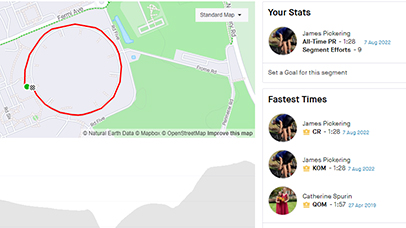
James is a relative newcomer to the School of Chemistry, joining us towards the end of 2021, and is a teaching-focussed academic with a strong interest in delivering high-quality teaching in physical chemistry and mathematics. James develops novel explanations and presentations that help students to explore and understand the complex physical phenomena that underpin chemistry.
Madras experience for Dr Blackburn
Our Director of Education, Richard Blackburn, spent a fantastic morning attending the International Conference on Service Learning and Science Communication, hosted by Madras Christian College and sponsored by the American Chemical Society. Richard was invited to present a lecture about the fantastic science communication initiatives that he runs within Leicester Chemistry, highlighting the use of infographics, and poster sessions for undergraduate project students. A great day of learning about science communication was had by all! You can read more about Richard's experiences via LinkedIn.
Cordell's New Concepts
Rebecca Cordell has been awarded £20,000 as part of the University of Leicester's New Concepts Fund for Early Career Researchers. In collaboration with John Holt, the project, utilising facilities at Space Park Leicester, concerns optimisation of trace surface deposited organic compound analysis for contamination testing of astro-material handling equipment. Congratulations Rebecca!
Representing the future of Analytical Science
The Analytical Science Network’s annual conference ‘Emerging Analytical Professionals’ took place from 13-15 May 2022. Chloe Davis, Sean Scott, and Hannah Hilton-Tapp from the Materials and Interfaces Group attended the three-day conference, which included oral and poster presentations from early career professionals in various roles within the analytical chemistry field.
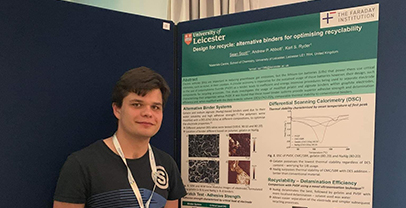
During the conference, Chloe presented a talk on ‘Electrochemical Analysis of the Galvanic Deposition Technique to Visualise Latent Fingermarks’ and Sean presented a poster entitled ‘Design for recycle: alternative binders for optimising recyclability’.
Bake Your Research
This Easter members of the School of Chemistry took part in a 'Bake Your Research' event for local universities, and team from the Doveston Lab won the 'Easter Showstopper' prize, voted for by a RSC East Midlands judging panel.
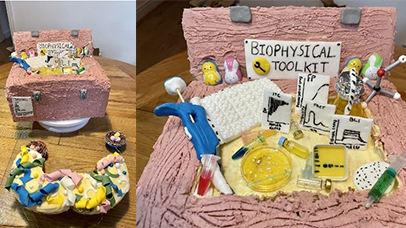
Above is the award-winning bake from the Doveston Lab, who are interested in using biophysical techniques to study the interactions between proteins (protein-protein interactions, PPIs). One protein of interest is called 14-3-3, a dimeric adapter protein. The bake shows their sophisticated biophysical 'toolkit' as well as the 14-3-3 dimer itself. A truly impressive effort!
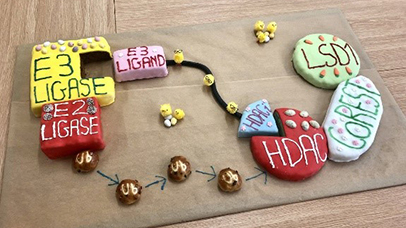
This entry represents work from the Hodgkinson group, who are interested in the synthesis of novel proteolysis targeting chimeras (PROTACs) for targetted degradation of Class I histone deacetylases (HDACs) in corepressor complexes via E3 ligase recruitment. Their bake represents all components of their complex systems using a variety of flavoured cakes, and ubiquitin (Ub) hot cross buns.
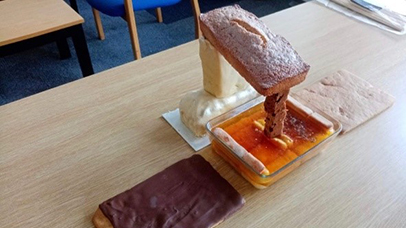
The final entry from Leicester came from Sean and Jennifer, two physical chemists interested in methods for simplification of recycling material from lithium-ion batteries. Their bake represents an ultrasonic delaminator which they use in their research, constructed from a fruit cake frame, sponge ultrasonic blade, jelly delamination solution, and gingerbread electrodes.
Peake-y Blinder for Atmosphere for Chemistry Researchers
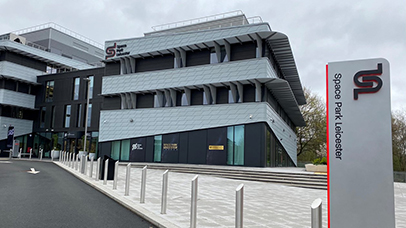
Atmospheric Chemistry researchers from the School are pleased to have moved into their luxurious new surroundings in Space Park Leicester. The laboratories were officially opened in March 2022 at a special 'launch' ceremony attended by UK astronaut Tim Peake, who received a tour of the site and spent time interacting with young scientists of the future.
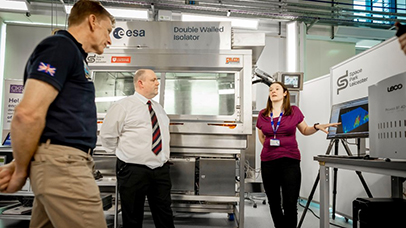
PhD student Doug Gregg, pictured below sampling the air inside Space Park Leicester, is particularly keen to make the most of the opportunities afforded by these world-leading facilities.
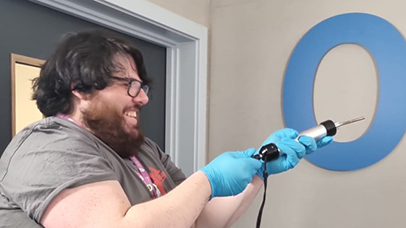
Flipping Marvellous: Pancake Day Celebrations
In the School of Chemistry's first social event for almost two years, our Pancake Day celebrations were a huge success and raised roughly £50 in donations for aid funds for Ukraine. A big turnout brought together the whole School, with undergraduates, postgraduates, academic, and technical staff joining together for the occasion. Josh and Meg spent 3 hours producing over 100 pancakes for the occasion, whilst Fabiana and Ginevra made a selection of Italian sweet treats for us all to enjoy!
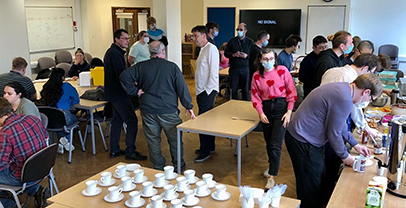
Science Marches on for Josh and co-workers
Huge collaborative efforts between members of the Hodgkinson, Cowley, and Schwabe groups, have been published in the Journal of Medicinal Chemistry. Led by Josh Smalley, this latest work on new Class I HDAC degraders shows that HDAC1/2 degradation is critical for induction of apoptosis and cell arrest in cancer cells.

'Optimization of Class I Histone Deacetylase PROTACs Reveals that HDAC1/2 Degradation is Critical to Induce Apoptosis and Cell Arrest in Cancer Cells', J.P. Smalley, I.M. Baker, W.A. Pytel, L.-Y. Lin, K.J. Bowman, J.W. Schwabe, S.M. Cowley, J.T. Hodgkinson, J. Med. Chem. 2022, 65, 5642.
An International Start to the Year
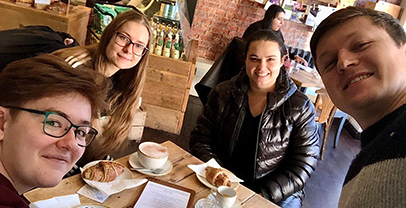
Aline Renata Pavan has joined the Hodgkinson group from Brazil. She is a PhD student from São Paulo State University (UNESP) where she is working on a project to develop HDAC1/2 inhibitors for the treatment of Sickle Cell Disease as part of the Laboratory of Drug Research and Development (LAPDESF) research group. As a whole her research group is housed within the School of Pharmaceutical Sciences and have been working to design and synthesise new compounds for neglected diseases, plus also cardiovascular, infectious, and inflammatory diseases. Welcome Aline!
Fabs Ortu part of team awarded RSC Horizon prize
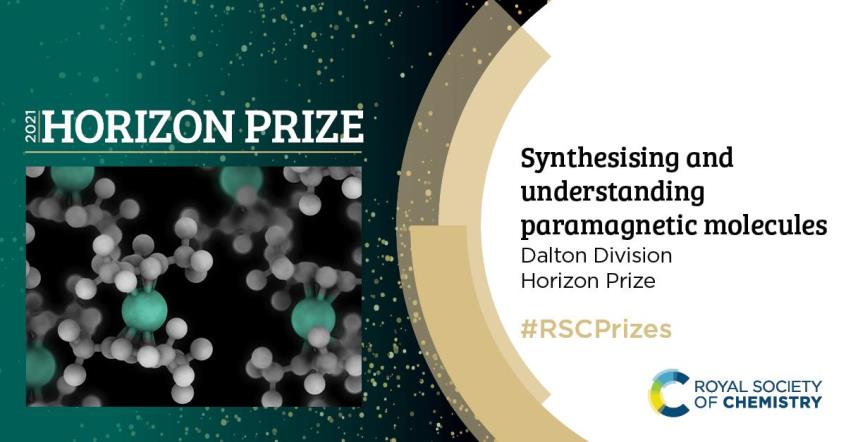
Dr Fabrizio Ortu is part of the Molecular Magnetism Team recognised with the 2021 RSC Dalton Division Horizon Prize. The Prize was awarded for carrying out cutting edge research in the field of molecular magnetism, as part of “A multinational team of synthetic, spectroscopic, magnetism, and computational researchers all working to a unified goal: generating and understanding ground-breaking paramagnetic molecules with novel potential applications.” Fabs contributed to this Award by studying Electron Paramagnetic Resonance spectroscopy applied to actinide chemistry (reported in Nature Chemistry), and high temperature single molecule magnets (reported in Nature).
Leicester Chemistry part of ERA-2 initiative
The School of Chemistry is taking part in a major new £250M Government initiative seeking to build the next generation of energy technologies in the Midlands. The Energy Research Accelerator (ERA) was established in 2016 as the UK's first cross-discipline energy research hub, bringing together over 1,400 researchers from across the Midlands with the aim of supporting the low-carbon transformation of the regions’ energy infrastructure, providing technical input to energy policy developments, and fostering knowledge exchange between partners within the sector. The first phase which ran from 2016 - 2020 focused on three themes; Thermal Energy, Geo-Energy, and Internal Storage. During this time the initiative has had high impact success, contributing to the development of key large-scale demonstrator facilities, supporting small and medium-sized enterprises through the delivery of ERDF projects worth over £50M, and implementing skills development programmes for midlands-based PhD students and Postdoctoral Researchers. Following the great success of the initial phase, ERA is now launching its second 5 year mission in which the University of Leicester’s School of Chemistry will continue to develop alternative energy sources by working on advancing the safety and performance of cell materials and chemistries. This includes the development of novel electrolyte technologies to implement the aluminium rechargeable cell and also developing novel methods for recycling and recovery of critical raw materials from spent cells.
Collaboration on a knife edge for Leicester chemist
Professor Rob Hillman has collaborated on a significant research paper into round-tipped knife blades, which has the high-impact potential to aid the reduction of knife crime and prevention of serious injuries.
The project was led by a University of Leicester Distance Learning graduate, Leisa Nichols-Drew (De Montfort), alongside colleagues Dr Rachel Armitage and Dr Kevin Farrugia, in collaboration with Dr Kelly Sheridan (Northumbria).
For the paper, entitled On a knife edge: A preliminary investigation of clothing damage using round-tipped knives, the team conducted 300 tests using a single downward stabbing motion on four garments, all made from different materials. The knives used for the experiment included: a blade with an ‘r-shaped’ tip; a blade with a rounded tip; a blade with an asymmetric tapered tip known as a ‘sheepsfoot’; a traditional pointed-tip blade; and a serrated-edged blade with pointed tip. The results revealed significant differences between the stab hole size and shape, depending on the design of the knife, with all but the rounded tip causing some form of damage. The rounded blade did not pierce any of the four fabrics whatsoever, leading researchers to call for conventional pointed-tip knives to be replaced with rounded-tips to minimise the risk of kitchen knives resulting in injuries. The research has the potential to assist in the future design of kitchen blades, as well as being of great interest to crime-reduction units, and has already garnered media attention with the findings being reported by the BBC.
New Horizons for metalloenzyme research at Leicester
Philip Ash has been awarded funding through the highly-competitive New Horizons program piloted by the Engineering and Physical Sciences Research Council (EPSRC). The project aims to develop novel ways of triggering fast reactivity in enzyme systems that will ultimately broaden the scope of serial crystallography methods at synchrotron and X-ray free electron laser light sources.

Advisory Panel membership for Leicester chemist
Philip Ash has been invited to serve as a member of the Life Sciences and Soft Materials Advisory Panel of the Science and Technology Facilities Council (STFC). The purpose of the Advisory Panel is to provide a link between the user communities, including potential future users, of STFC facilities such as Diamond Light Source, ISIS Neutron and Muon Source, the Central Laser Facility, and international facilities such as the Institut Laue Langevin and European Synchrotron Radiation Facility in Grenoble, where the STFC provides access for UK-based researchers.
Editor's choice for Jenny Hartley
Dr Jenny Hartley from the Materials and Interfaces Group has had a paper published entitled The effect of pH and hydrogen bond donor on the dissolution of metal oxides in deep eutectic solvents. The paper was selected as the Editor’s Choice article in the high-impact Royal Society of Chemistry journal Green Chemistry . A blog post showcasing the publication has been released by the Green Chemistry Blog.
Bumper grant success to start the year!
- Dr Rama Suntharalingam and Professor Andy Abbott successfully obtained a £176k Knowledge Transfer Partnership with a Leicester-based company Food Attractions aimed at investigating moisture transport in foods and hence improving product quality and shelf life.
- The Materials Group (Professor Andy Abbott, Professor Karl Ryder, Professor Gawen Jenkin and Dr Dan Smith) has been successful in obtaining a £958k grant from the UKRI to research methods of creating a Circular Economy in Technology Metals. The project with Exeter, Manchester and Birmingham Universities, together with the British Geological Survey, aims to develop efficient extraction and recycling processes.
One is the loneliest number?
Shengfu Yang and his co-workers in the Spectroscopy and Atmospheric Chemistry Group discovered single gold atoms within Van der Waals complexes can serve as catalysts. This was observed in ionization-induced chemistry of 1,6-hexanediol-Au and 1,8-octanediol-Au complexes formed in superfluid helium nanodroplets, where the addition of gold atom(s) made C2H4+ the sole prominent product in dissociative reactions. Quantum calculations revealed that the gold atom significantly weakens the C-O bonds while simultaneously strengthening all of the C-C bonds, making the C-O bonds the weakest bonds in the molecules. This work suggests a new strategy in catalysis and may aid future rational catalyst design. The finding was published in Chemical Science, and highlighted by Chemistry World.
Have your cake and eat it
PhD student Josh Smalley has taken part in ‘Bake Your Research’, a fun challenge in which researchers are set the tasty task of representing their work in cake form.
As part of the Hodgkinson group in the Leicester Institute of Structural and Chemical Biology, Josh’s research is focused on the synthesis and investigation of Proteolysis Targeting Chimeras (PROTACs); heterobifunctional molecules that function to catalytically degrade a protein of interest (POI) via the ubiquitin proteasome system. The POI in question for Josh’s research are the Class I histone deacetylase (HDAC) enzymes. The PROTAC general structure is a POI inhibitor connected via a linker to an E3 ligase ligand. In binding to its respective targets the PROTAC recruits the POI to an E3 ligase, forming a ternary complex. Subsequent polyubiquitination occurs through successive transfers of ubiquitin (a 76 amino acid protein) to the POI, which then triggers a response by the proteasome to selectively degrade the POI and subsequently knockdown POI levels.
Josh has done a great job of creating a delicious-looking representation of his research! Josh has also recently had a paper published in collaboration with the Schwabe and Cowley Groups, entitled PROTAC-mediated degradation of class I histone deacetylase enzymes in corepressor complexes.
A scholar of distinction
Richard Blackburn has been awarded a University Distinguished Teaching Fellowship. The achievement was awarded ‘in recognition of the commitment Richard has to continuing innovation both in his own teaching and in fostering it in others: locally through mentoring, regionally through the Royal Society of Chemistry and internationally through publications and conferences'. Richard is a highly valued member of the School of Chemistry and rated consistently high by his students. He adopts a variety of teaching methods to ensure the best possible outcomes for a diverse student body.’ Many congratulations to Richard on this impressive accomplishment!
STOP PRESS: Richard has also just been promoted to Associate Professor, so it’s double congratulations!
Leicester students help find tools to cure rare disease
Ten School of Chemistry BSc students (Hasan Abosoglu, Alfeshani Cassim, Edmund Chu, Simon Doughty, Shaun-Jones Eganda, Hikari Fuchigami, Aleah Hussein, Meedhu Olickal, Neelay Parmar and Akhil Sebastian) have contributed to the CureCN project, funded by the EU’s Horizon2020 research and innovation program (award number: 755225). The students were supervised by Sergey Piletsky, Kal Karim, Elena Piletska and Fabiana Grillo. The main objective of the project was to produce a tool for improving the efficiency of gene therapy used in the treatment of Crigler-Najjar (CN) syndrome, a genetic disorder characterised by an inability or diminished ability to convert and clear bilirubin from the body.
The students developed synthetic binders for adeno-associated virus (AAV) - neutralising antibodies. These materials are in high demand as a solution to one of the biggest problems associated with the practical application of gene therapy in genetic disorders – the decreasing efficiency of the treatment over time because of the patient’s immune response. A combinatorial library of fluorescent polymeric nanoparticles was prepared and screened against six peptide epitopes of the variable regions of the AAV - neutralising antibodies, which were identified by the Leicester Biotechnology Group, a partner in the EU project. Students provided a thorough investigation of the components of the monomeric mixture that had a positive or negative impact on polymer binding to the peptides with a different composition and properties. This study produced valuable information for experts who use material engineering to solve practical problems related to nanotechnology and drug delivery.
Fishing for inspiration
A team of eight undergraduate students (Georgia Battersby, Corey Beeley, Danielle Baguley, Harrison Barker, Harvey Broad, Niamh Carey, Edward Chambers and Daria Chodaczek) along with Dylan Williams and Richard Blackburn (Leicester Chemical Learning Enhancement and Pedagogy) are celebrating publication in the Journal of Chemical Education (Go Fischer: An Introductory Organic Chemistry Card Game).
The paper details a Go-Fish inspired card game developed by six of the co-authors (Danielle, Harrison, Harvey, Niamh, Edward and Daria) during their first year at University (back in 2017). The game was designed to help students practice applying the rules of organic nomenclature, to recognize key functional groups, and to familiarise themselves with simple examples of reactivity of molecules containing these functional groups. The effectiveness of the game as a learning resource was evaluated by Georgia and Corey as part of their final year dissertation projects (under the supervision of Dylan and Richard). Publication in the prestigious Journal of Chemical Education means the game is now available for students and educators around the world to use.
Apart, but celebrating together
Although the COVID-19 crisis prevented any of the normal summer graduation celebrations taking place this year, we consider festivities postponed rather than cancelled! We intend to to invite all graduating students from 2020 to a formal graduation ceremony in the future.
We didn't want our students achievements to go unnoticed, however, and so we held an online graduation celebration on 14th July. This session included lots of video clips from past and present students and other members and friends of the University, including the President and Vice Chancellor, Prof. Nishan Canagarajah. The session itself was a live event compered by the Head of School, and an edited version is available on YouTube.
Congratulations to all of our graduates in 2020 and best wishes for the future!
European funding success
Karl Ryder and the Materials and Interfaces Group have been awarded a European Commission H2020 grant for a new two-year project titled ‘A Marketable Polymer based Al-S battery’ (AMAPOLA). The project will expand upon the research conducted in the ‘Sulfur-Aluminium Battery with Advanced Polymeric Gel Electrolytes’ (SALBAGE) project. AMAPLOA will focus on using the research results obtained by SALBAGE to create genuine technological innovations in the Al-S battery market.
Congratulations to all involved!
Award-winning investigator!
Rama Suntharalingam (Associate Professor in Inorganic Chemistry) was awarded the Royal Society of Chemistry Inorganic Biochemistry Discussion Group Investigator Award for 2020, for “sustained, high quality contributions in the area of metallo-drug design and development.” This award recognises excellence in inorganic biochemistry for a researcher who is 10 years post-PhD and employed in any UK institution.
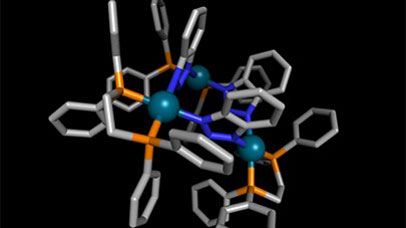
Since joining the University of Leicester last year, the Suntharalingam group have published four independent publications in peer-reviewed journals. The group reported the first investigation into metal-based anti-osteosarcoma stem cell agents in Chemical Communications, and the first multi-nuclear palladium(II) complex to potently kill breast cancer stem cells in Dalton Transactions. The group also reported on the anti-breast cancer stem cell properties of nickel complexes in ChemBioChem and Chemistry – A European Journal.
International reach of Leicester's chemical education research
Richard Blackburn was invited to give a seminar at the Hong Kong University of Science and Technology (HKUST) by assistant professor of chemistry education, Jason Chan.
His seminar, jointly hosted between chemistry and the university’s centre for education, was entitled “digital & graphical teaching innovations for laboratory instruction and science communication”. In this seminar Richard highlighted the broad range of resources developed at Leicester to better prepare students for laboratories, his problem solving activities to teach synthesis and retrosynthesis and his novel ways to assess science communication.
Kal in the community
Kal Karim has raised over £12,000 for the Cambridge City Foodbank during the Covid-19 pandemic.
The crisis means that foodbanks nationwide face a time of uncertainty due to isolation guidelines and depleting resources. When he initially set up the online fundraiser in March, Kal had a target of raising £2,000 to help his local foodbank remain open and continue aiding those in need. Since launching, he has smashed his original target and, thanks to the generosity of the public, the target has been increased to £15,000. Kal has since appeared on local radio and television to raise support for his campaign.
Undergraduate journal success
Catherine Feld, a final year MChem student in the Suntharalingam group, has published her MChem project results on the anti-breast cancer stem cell properties of nickel complexes containing non-steroidal anti-inflammatory drugs in Chemistry - A European Journal, with help from Dr Alice Johnson and Dr Zhiyin Xiao.
This is an outstanding feat for an undergraduate student and a testament to Catherine’s hard work and tenacity throughout the year. Congratulations!
Looking good, naturally
Alvaro Garcia Cruz, a Research Associate in Chemistry, and Katrin Scionti (Immunology) have co-founded a skincare company with the support of the Leicester Innovation Hub.
Alvaro and Katrin used the lock-down period as an opportunity to realise their dream of establishing a natural cosmetic company, Gamanity Cosmetics. The past few months have seen the pair register the company and have their products certified, while also building an international following on social media. Gamanity Cosmetics products are environmentally friendly as they are made from organic and natural ingredients, and the packaging is fully recyclable and plastic-free. Some of the company’s best-selling products are their Natural Deodorant and Lip Balm.
The company has also begun the process of establishing a worldwide community with the aim of keeping people informed about healthy and safe skincare products and practice, as well as providing a platform to exchange ideas and promote important issues. Gamanity is dedicated to actively supporting women’s empowerment. The company plan to organise monthly webinars featuring talks by inspirational women and have future plans to support charities dedicated to women’s employment.
Alvaro and Katrin are very proud of the progress they have made and are excited to develop their company further. They would like to say a huge thank you to their mentors at the Leicester Innovation Hub for their help and support.
University Challenge
School of Chemistry graduate Tom Purnell captained the University of Leicester team in a first-round match against the University of Durham on the latest series of University Challenge.
Tom graduated with an MChem in Chemistry in 2019 and has gone on to study for a PGCE with Science. The match was a closely run contest, with the teams pitted against each other on subjects varying from political history and arithmetic to romantic literature and flags of the world. While the final score saw Leicester beaten by Durham, 125 – 180, the team showed an excellent breadth of knowledge and sportsmanship. Well done!
Maple League appointment for Leicester alumnus
Professor Andy Hakin has recently been appointed as the President and Vice-Chancellor of St Francis Xavier University in Canada. StFX is located in Antigonish in Nova Scotia on Canada’s east coast, and is a member of the Maple League universities in Eastern Canada.
Andy did his first degree in Chemistry at the University of Leicester and remained here to do a PhD under the supervision of Mike Blandamer, graduating in 1987. He then did postdoctoral work at the University of Alberta and has worked in Canada ever since. Prior to arriving at StFX he was a Professor of Chemistry at the University of Lethbridge and served as their Vice President for Academic Affairs and Provost for the 13 years. His move to StFX started on 1st July 2020.
Andy’s wife, Linda, is also a graduate of the University of Leicester and holds a BA in Economics and Economic History. We wish Andy and Linda all the best and hope to see them in Leicester on a future visit.
New atomic-resolution imaging capability for Leicester
Installation and commissioning of a new Atomic Force Microscope (AFM) took place in late August in the Centre for Materials Research. This is an exciting development, adding even more cutting-edge technology to the comprehensive suite of surface characterisation facilities already assembled in the Centre and the Advanced Microscopy Facility. The new AFM has the capability to create 3D images of a surface at the nanometre scale. It is also capable of imaging the positions of arrays of individual atoms, giving scientific insights into the structure of materials that could only have been dreamt of before!
The microscope, costing nearly a quarter of a million pounds, arrived from the USA packed in huge wooden crates that, in a heart-stopping moment, almost literally fell off the back of the lorry! The manufacturer, Bruker, installed the instrument and initial training was completed just after the August bank holiday. The new AFM was funded from a Faraday Institution grant awarded to Andy Abbott and Karl Ryder, focussing on the recycling of battery waste and the recovery of strategic metals such as nickel, cobalt, cooper, aluminium, and other reusable components. The microscope will be used to study the surfaces of battery-related materials as they are dissolved away and deposited in electrochemical processes (charging and discharging). This will help us to understand and optimise how we treat battery materials and minimise waste, as well as provide insights into new battery cell chemistries. In addition, the new microscope will be used to support range of materials-related projects funded by the EU Horizon 2020 (project SAlBaGE), Innovate UK (projects CRUPPAIL, CHROMFREE), the Home Office and a range of industry partners and commercial contractors. The AFM will also support work on forensic materials (Rob Hillman), minerals processing and recovery in collaboration with colleagues in the School of Geography, Geology and the Environment as well as energy related research currently being developed by the University of Leicester in the College of Science and Engineering in partnership with Midlands Universities and energy stake holders under the major funding initiative of the Energy Research Accelerator (ERA).
VIP article for Leicester chemist
Recently published research by Richard Hopkinson has been selected as a VIP article in ChemBioChem. The article describes biochemical studies on an oxygen-dependent formaldehyde-producing demethylase, KDM4A, which contains a key lysine residue in its active site. Combined MS and NMR analyses suggest this lysine residue (lysine-241) is essential for ensuring efficient demethylation activity, but does not affect KDM4A’s reaction with oxygen. The work implies that small molecule binders to lysine-241 in KDM4A may induce catalytic inactivation.
Detoxifying Cadmium
A project within the Centre for Materials Research, ‘Cadmium Replacement Using Pulse Plating And Ionic Liquids’ (CRUPPAIL), has been shortlisted for an Environmental achievement award at The Surface Engineering & Heat Treatment Awards (SEA).
The CRUPPAIL project intends to produce a more environmentally friendly replacement for cadmium plating by developing a new chemical process which can plate zinc-nickel (ZnNi) alloys. Cadmium is a coating for metals that gives excellent anti-corrosion and lubrication properties but the feedstock material is very toxic. Use of Cd is still allowed in the EU but only for some strategic aerospace and military applications. The global economy is searching for an alternative to cadmium and this has been achieved through the use of novel ionic liquid non-aqueous chemistry and deep eutectic solvents, allowing creation of safer coatings while maintaining the technical properties of cadmium.
The CRUPPAIL project is a small consortium including a Birmingham-based commercial electroplating company, experts in waste minimisation, treatment and surface engineering and is funded by Innovate UK. The role of the University of Leicester is to develop and produce the novel electrolyte. This task is being led by Chunhong Lei and Karl Ryder in the Department of Chemistry.
The SEA Awards bring together the entire surface and heat treatment industry, including customers, suppliers and members of the organization. The awards ceremony will be held in Manchester in October.
Fifty Shades of Grey for materials researcher
Artwork by PhD student Stylianos Spathariotis, ‘Fifty Shades of Grey’, has been selected for display in the annual open exhibition at New Walk Museum. The piece combines the science of metal recovery with a state-of-the-nation political message. Using the cementation process (the precipitation of a noble metal when it comes into contact with a less noble one), Stylianos dissolved a variety of metal salts in an ionic liquid before brushing them onto galvanised steel. The reactions resulted in a patchwork of fifty grey deposits forming the figure of the Union Jack.
Stylianos intends for the piece to highlight the multicultural and multinational nature of Great Britain, while also promoting social equality via the uniform ‘grey’ quality afforded to all metals, both precious and abundant, regardless of their perceived economic value.
Fluorine future is in good hands
Five members of the Fluorine Research Group enjoyed attending the 18th RSC Fluorine Subject Group Postgraduate Meeting at the University of Southampton in April 2019. Martyna Urbonaite gave an excellent oral presentation on “Metal-free fluorocyclisations with the hypervalent fluoroiodane reagent”. There were also two poster presentations; one from Yixin (Alice) Xie, and a joint poster presented by Harsimran Minhas and William Riley. Congratulations to Simran and Will for winning the prize for the best poster presentation!
Latest Guardian league tables
The chemistry department has been ranked 13th out of 55 UK chemistry departments in the Guardian University League Tables 2020. The department scored 3rd and 7th for career prospects and Nation Student Survey feedback, respectively.
Needless to say we are delighted that continued efforts in enhancing the courses, innovating our teaching, embedding careers events, and supporting students throughout their study has been reflected in such a positive outcome from this key league table.
Young Investigator Award for Richard Hopkinson
Parasites under the spotlight: applications of vibrational spectroscopy to malaria research
Corey Evans and Andrew Hudson from the Department of Chemistry have co-authored a paper together with long standing collaborators from Monash University, an institution in Victoria, Australia.
The article published in Chemical Reviews, a journal published by the American Chemical Society, contains insights from research on the application of vibrational spectroscopic techniques for monitoring and detecting malarial infection with high sensitivity and specificity. New technologies to diagnose malaria are urgently needed in the developing world where the disease continues to pose a huge burden on society. Although the article is primarily a review, it also contains some new data recorded during a recent visit made by Andrew Hudson to Monash University (supported by a Royal Society International Exchanges grant), which was analysed using multivariate algorithms back in Leicester by both Andrew Hudson and Corey Evans.
Gum control
Shengfu Yang appeared on the BBC OneShow in July, talking about the chemistry and the recycling of chewing gums.
His segment was filmed in the first floor Chemistry Lab, where Shengfu explained the polymeric nature of chewing gums, why they are so sticky and how difficult it is to breakdown the gum waste. He also performed interesting experiments which compared the degradation of apple and chewed gum in gastric acid, and how these can be destroyed by burning. Although chewing gum waste can be burnt, this is not an ideal solution for its removal as this method clearly has both environmental and energy indications.
Our streets and pavements are now suffering from a monstrous plague of spat-out chewing gums, and the UK spends ~£60 million per year on gum removal. Chewing gum wastes have now raised a great concern. The major component making the “chew” of the gums is plastics, which is flexible and stretchable, but hard to break down into small molecules. Once they are spat on the street and stepped on, they become little disks that stick strongly with the surfaces, making removal difficult. At the molecular level, this is due to the hydrophobic nature of plastics and the road surfaces, which defines the strong attractive interaction between them.
Fluorine research highlighted by the BBC
Professor Andrea Sella from University College London has presented a series on Radio 4 called “In Their Element”. In the episode on “Fluorine: Chemistry’s Tiger”, Dr Alison Stuart, Chair of the RSC Fluorine Subject Group, provided commentary on the role of fluorine in modern day pharmaceuticals.

Reduce, reuse, recycle to electrify transport
Dana Thompson recently started her PhD in the Materials Centre at the University of Leicester as part of the Faraday Institution project, ReLiB (Recycling of Lithium Ion Batteries). ReLiB is a very exciting project involving over 50 researchers from 8 institutions across the UK. The overall goal of the project is to develop a lithium ion battery recycling industry in the UK. Her role within the project is to investigate the properties of the battery materials and to develop a catalytic method to split the materials into their individual components.
In November she attended her first conference in Daventry where she presented work on the mechanical and optical characterisation of unwetted lithium ion electrodes. She also spent an afternoon at Williams Advanced Engineering looking at some of the diverse applications of lithium ion batteries and we got an insight into the power units of Formula E vehicles.
Dana has also visited Newcastle University with the Faraday PhD Cluster for a 5-day course on battery safety, learning how to isolate a Nissan Leaf. The group also visited Hyperdrive, a battery supplier for electric vehicles and learnt about charging protocols. On our final day we went around the production line at the Nissan factory.
Leicester chemist wins prestigious Royal Society of Chemistry Award
Dr Dylan Williams, of our Department of Chemistry, is the Royal Society of Chemistry Higher Education Teaching Award winner for 2018.
Dr Williams has worked on new ways of teaching chemistry at university since 2007. His approach is based on learning experiences that allow students to work in teams on open-ended problems, developing their chemical and workplace skills.
SCI award for Leicester undergraduate
Congratulations to Joshua Smalley who collected the runner-up prize for best oral presentation in the 2018 SCI undergraduate symposium in Liverpool. The event, aimed at sharing undergraduate research, invites final year undergraduate students to give a short talk on their research project. This year's event hosted 16 speakers from 10 different universities. Josh presented his project, which he undertook with James Hodgkinson, on the 'Design and Synthesis of PROTACs for targeted degradation of epigenetic regulators'. Josh will start a Ph.D with James this September.
Sharing teaching excellence and innovation in Chemistry
The University’s annual Discovering Teaching Excellence conference took place June 12th 2019. The department was very well represented at the conference with students and staff giving four talks, one poster, and hosting a table at the “World Café” event and two award presentations.
Two students were awarded Teaching Partnership Awards:
- Leanne Blount (PhD) for work on innovative ways of supporting student learning in the teaching lab environment. Leanne is now working with Richard Blackburn on getting this work published.
- Nikita Lack (BSc Chem w/Forensic Science) for working with Richard Blackburn on a project to produce a series of videos to help students build models as part of a flipped lecturing approach. Nikita has also made a significant contribution to the “Science in a Box” outreach project.
The following talks were given:
- Natalie Rose (BSc Chem w/Forensic Science) presented on her work with Harry Howells (BSc Pharm Chem), Richard Blackburn and Barbara to develop and evaluate Lab360: a virtual tour of the chemistry teaching lab.
- Leanne Blount (PhD) presented on her innovative approach to supporting student learning in the teaching lab using picture boards.
- Dylan Williams presented on a student partnership with Mariam Mahomed (BSc Pharm Chem), Lakshmi Sisodia (BSc Pharm Chem) and Barbara on the development and evaluation of a lab-based escape room for use as part of our outreach programme.
- Richard Blackburn presented on his work to develop an innovative infographic-based assessment for first years that allows students to learn more about research in the department. The work presented by Richard has been published in the Journal of Chemical Education.
A student-staff partnership team consisting of George Tebbutt (MChem), Charlotte Dickenson (MChem), Natalie Rose (BSc Chem w/Forensic Science), Barbara Villa Marcos and Richard Blackburn presented a poster on current work being done in the department as part of the Digital Innovation Partnership initiatives.
Finally, Dylan Williams hosted a table at the “World Café” to discuss how to support student engagement through innovative teaching and learning approaches. This event also focused on advising staff how to obtain National Teaching Fellow status.
Chemical education pioneers visit USA
Richard Blackburn and Dylan Williams recently attended the he 25th Biennial Conference on Chemical Education (BCCE) hosted by the University of Notre Dame, South Bend, IL. This conference is a national meeting sponsored by the Division of Chemical Education of the American Chemical Society, aimed at promoting research, practice, and general innovation in the teaching of chemistry.
Whilst at the conference both lecturers made two presentations each, showcasing their research and innovations in problem based learning, student skills perceptions, pre-laboratory simulations, and alternative ways to teach organic chemistry (titles below). Additionally, both also participated in a number of networking and internationalisation events and workshops.
Talk Titles:
- Open Ended team-based induction task to support the development of project skills.
- Measuring the expectations of new chemistry students.
- Impact of pre-laboratory simulations on student attitudes of a first year laboratory course.
- Effectiveness of flipped problem classes and discussion to assist case-study teaching of synthesis.
More about pedagogic research and education innovation at Leicester can be found on the Chemical Learning Enhancement and Pedagogy Group webpages.